For Pre-PMF Startup Founders
Stop Guessing.
Start Tracking PMF.
Systematic way to measure, track, and prove product-market fit - replacing gut feelings with credible data your team and investors can trust.







Problem
Most startups fail cause nobody needs them
90% of startups never make it. Don’t be one of them.

42%
Startups fail due to lack of market need
1. Startups often prioritize building their product without validating the need for this product.
2. This leads to wasted resources and a failure to gain traction.
3. If you want to survive, you need to understand your audience & validate your hypotheses.

74%
Tech startups scale pre-maturely
1. Founders often pursue growth, before they’ve even proven the value.
2. Startups that scale prematurely get killed by the inefficiency of bloated organization.
3. If you want to scale, you need to track your progress towards Product-Market Fit.

<15%
Seed-funded startups reach Series A
1. Rising interest rates & unstable geopolitical situation have led many investors to pull back from venture capital funding.
2. Seed-stage startups end up running out of money before reaching next funding round.
3. If you want to raise your next round, you need to show clear PMF traction.
How it works
How PMFtracker Works
A simple 3-step 'CTA' process: Collect, Track, Act
01
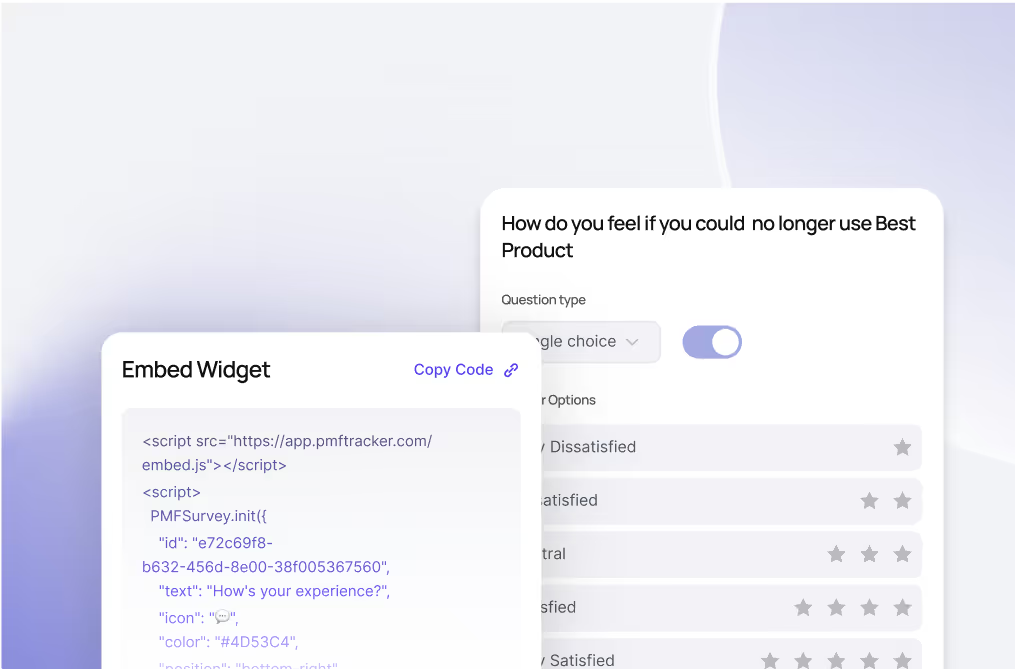
Set up PMF Survey
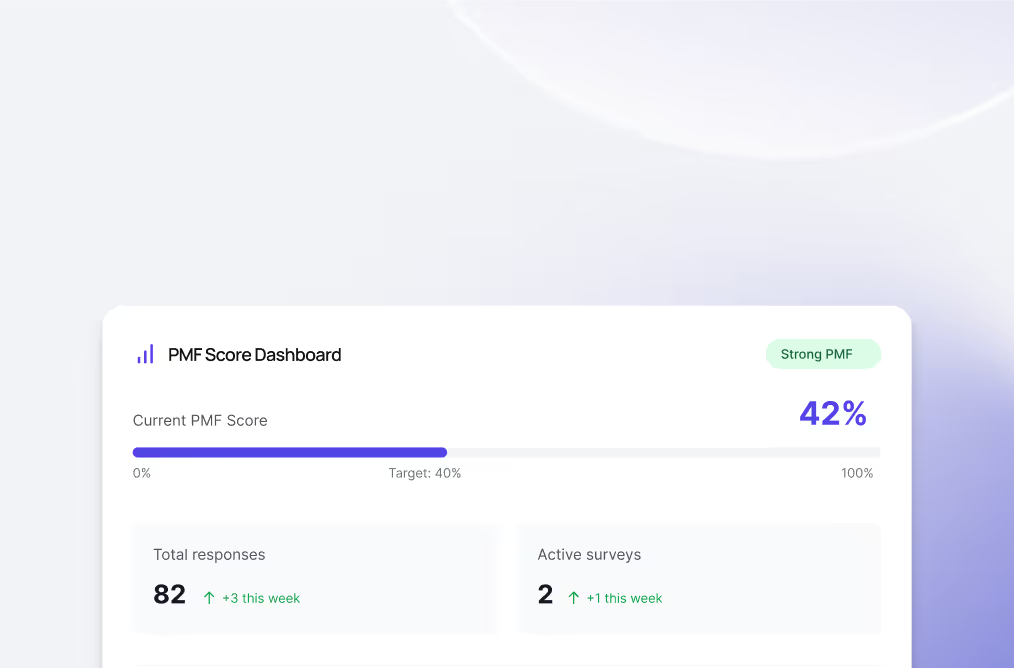
Measure PMF Score
02
03
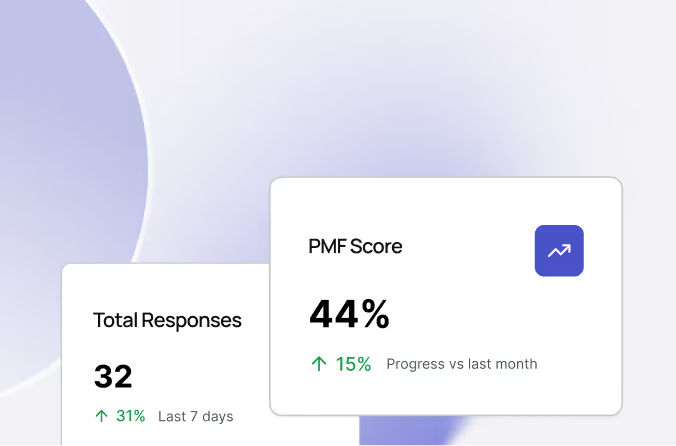
Analyze and Take Action
Testimonials
What Founders Are Saying
Startup founders who replaced intuition with systematic PMF measurement.

Olek Uznanski





"Seeming happy and gut feelings don't prevent the 42% startup failure rate. Data does. This is why I'm obsessed with quantified PMF measurement."
Using PMFtracker for:
12 months

Jad Duggal





"The 'Sean Ellis score' is a key element of how Nubank measures product-market fit and makes decisions about investing in new products. The score is based on asking customers, 'How disappointed would you be if this product went away?'"
Using PMFtracker for:
Solution
Complete PMF Measurement Suite
Everything you need to track and achieve product-market fit systematically.
Get instant visibility into your Product-Market Fit progress by tracking PMF score changes. Get clear instructions whether to focus on scaling and growth or iterate on your product.
1. PMF Score based on 40% rule
2. Historical trend analysis and forecasting
3. Benchmark against industry standards 4. Automated alerts for significant changes
Identify your most valuable customer segments and receive specific, actionable recommendations powered by synthesis analysis. Make targeted improvements based on segment-specific insights
1. Automated customer segmentation
2. Ideal Customer persona identification
3. Feature Prioritization recommendations
4. AI-Powered Sentiment Analysis
Showcase your product-market fit traction to investors and ease your way into the next funding round.
1. Standardized PMF measurement
2. VC access request management
3. Access to new investors
4. Investor-ready reports
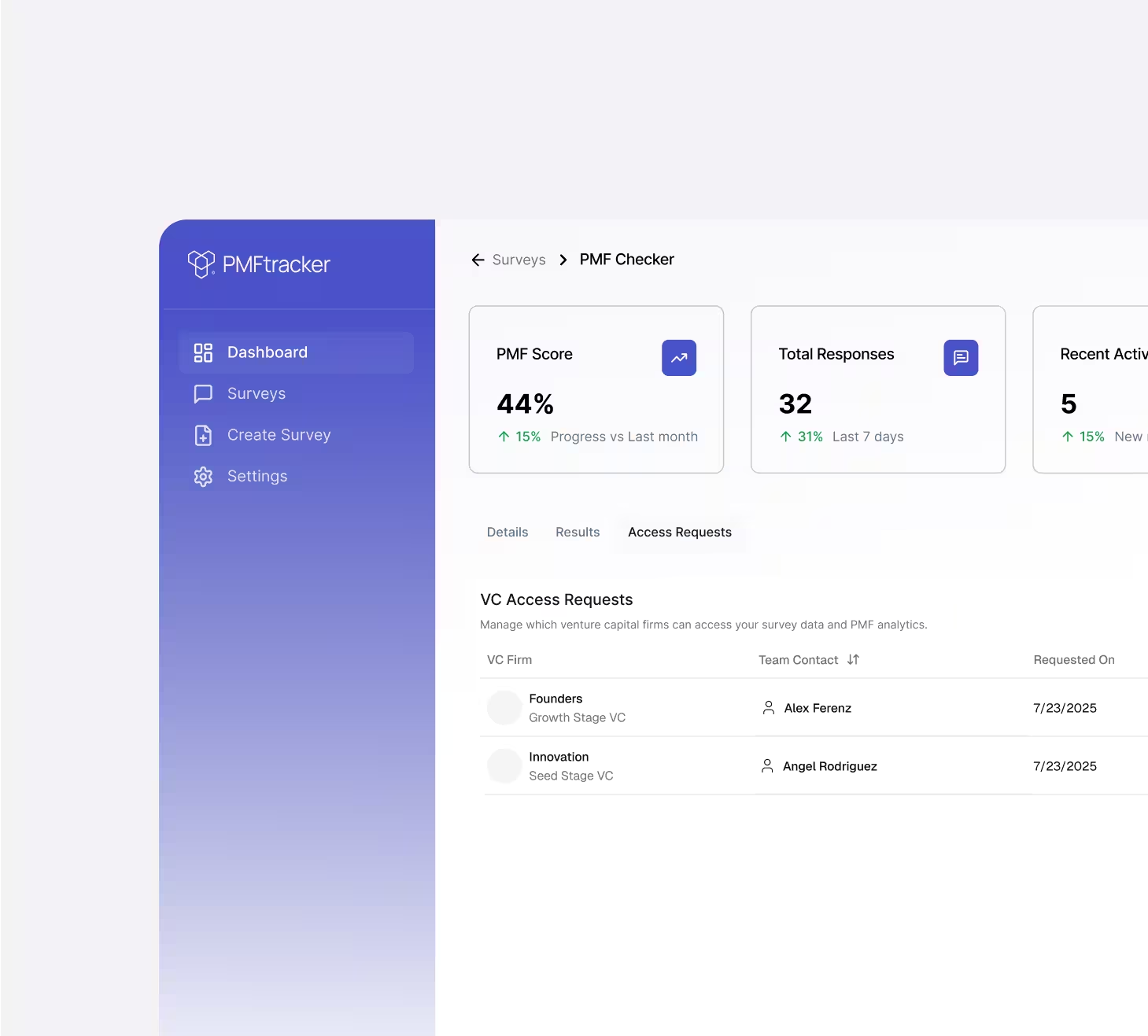
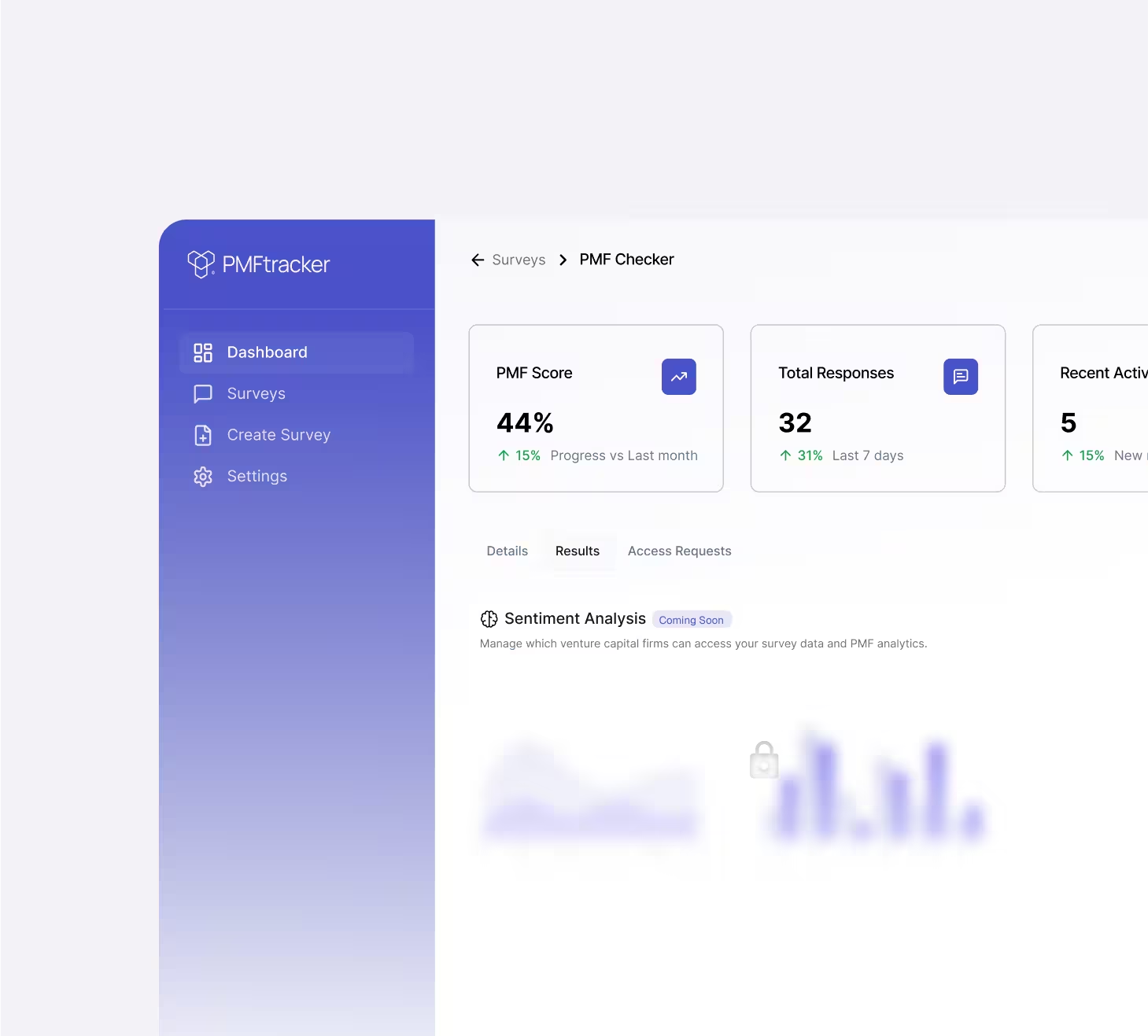
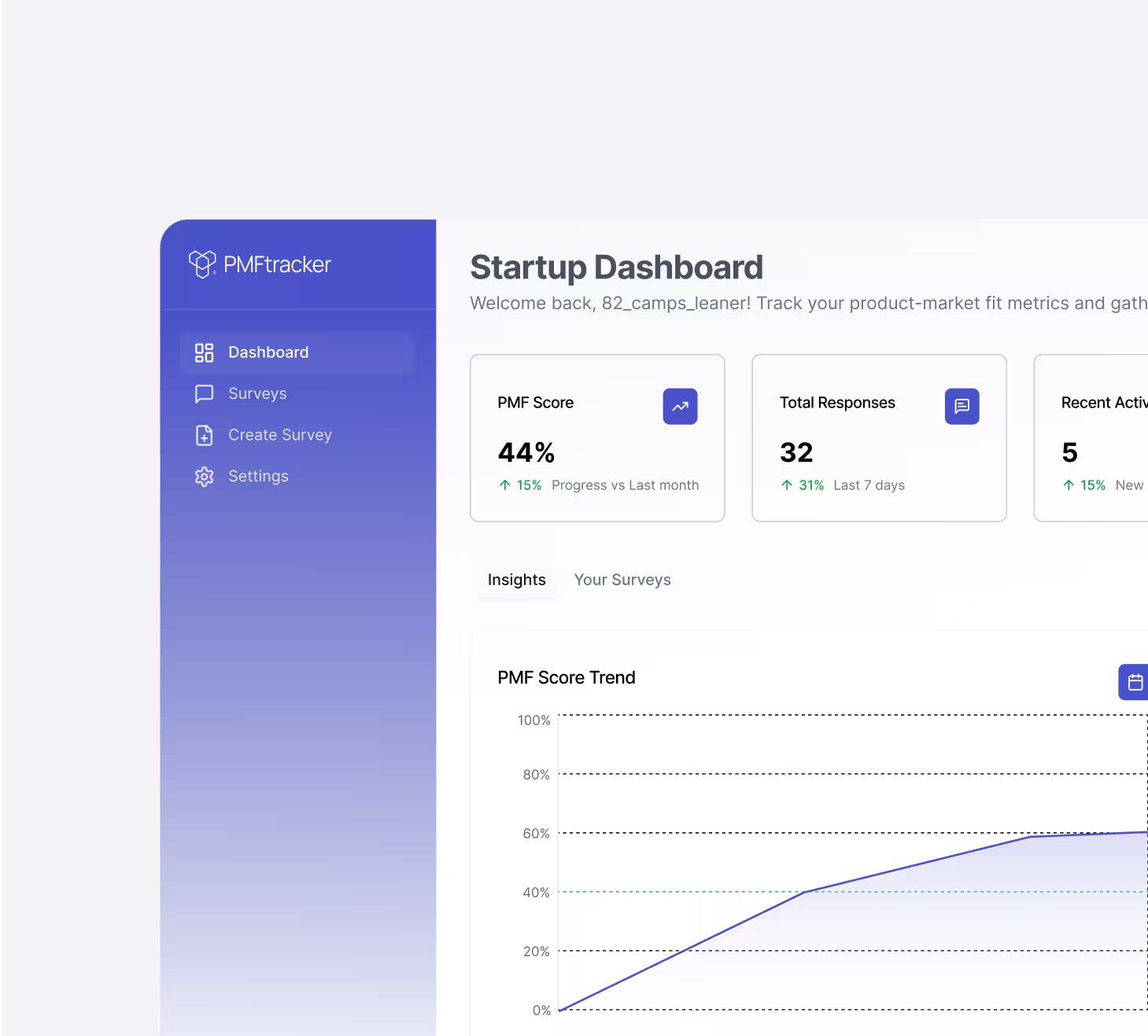
Price
Choose Your Plan
Start your PMF journey with our Bootstrap plan, then upgrade to access VC showcase features when you're ready to raise funds.
Bootstrap Founder
$9 per month
For solo founders validating their ideas
1 active survey
Unlimited responses
Advanced PMF Scoring
Custom branding
AI-powered sentiment analysis
VC showcase access
Import existing PMF survey responses from external tools
Startup
$19per month
For startup teams ready to showcase to VCs
Unlimited surveys
Unlimited responses
Advanced PMF Scoring
Custom branding
AI-powered sentiment analysis
VC showcase access
Import existing PMF survey responses from external survey tools
FAQ
Frequently Asked Questions
Everything you need to know about measuring product-market fit
PMFtracker provides both quantifiable metrics and structured qualitative insights that go far beyond casual user conversations. While talking to users gives general feedback, PMFtracker uses the proven Sean Ellis methodology to systematically measure product-market fit through the 40% rule - where at least 40% of users must say they'd be "very disappointed" without your product.
Beyond the quantitative PMF score, PMFtracker captures rich qualitative data through strategic survey questions that reveal:
1. Who your biggest supporters are - by segmenting users based on their "very disappointed" responses to identify your high-expectation customers
2. Why users love your product - through analyzing what main benefits resonate with your most passionate users
3. What holds users back - by examining feedback from "somewhat disappointed" users who share your product's main value proposition but need specific improvements
4. Product roadmap priorities - using customer language and requests to guide development decisions
This systematic approach transforms scattered user feedback into actionable product strategy. As Superhuman demonstrated, you can use these qualitative insights to double down on what users already love while simultaneously addressing barriers that prevent others from becoming advocates . PMFtracker structures this entire process, providing investor-ready reports that demonstrate both market validation through hard metrics and deep customer understanding through qualitative analysis.
The key difference is that PMFtracker doesn't just collect opinions - it creates a repeatable engine for optimizing product-market fit based on both quantitative benchmarks and qualitative customer insights .
Results can be seen as quickly as 1-2 weeks after implementing PMFtracker, though meaningful PMF validation typically requires 40-100 responses from users who have experienced your product. The platform provides real-time data visualization and dashboards that show immediate trends in your PMF score. However, achieving true product-market fit is an iterative process that can take months or even years for some companies, with PMFtracker helping you track progress and identify improvement areas throughout this journey.
PMFtracker requires a minimum of 40 responses for a statistically reliable PMF score, though it's recommended to collect at least 100 responses to gain deeper qualitative insights. The key requirement is that respondents must have used your product long enough to understand its features and value proposition. For early-stage startups, this makes PMFtracker accessible even during the MVP phase, allowing you to begin measuring PMF from the earliest stages of product development.
PMFtracker provides quantifiable metrics and professional reports that demonstrate traction to investors. Instead of relying on subjective user testimonials, you can present concrete data showing your PMF score, retention rates, and progress toward the critical 40% threshold. The platform generates investor-ready dashboards and reports that show market validation, user engagement trends, and clear evidence of product-market alignment - key indicators that VCs and investors look for when evaluating startup potential.
PMF should be measured regularly as you iterate on your product, typically monthly or quarterly. PMFtracker enables continuous monitoring rather than one-time assessments, allowing you to track how product changes impact market fit over time. Regular measurement is particularly important when launching new features, entering new market segments, or making significant product pivots.
Currently, PMFtracker integrates directly with PostHog for seamless data collection and analysis. The platform also provides a CSV upload option, allowing you to import survey results if you've previously conducted PMF surveys using other tools like Typeform, SurveyMonkey, or Google Forms. PMFtracker plans to build additional integrations with other popular analytics and customer management platforms in the future, ensuring you won't need to completely overhaul your existing tech stack to start measuring PMF effectively.
PMFtracker makes it easy to import your existing survey data through its CSV upload feature. Whether you've used Typeform, SurveyMonkey, Google Forms, or any other survey tool, you can upload your historical PMF survey results to immediately start tracking your progress within PMFtracker's comprehensive analytics dashboard. This ensures you don't lose valuable historical data when transitioning to a dedicated PMF measurement platform.
No, PMFtracker works for any product or service seeking to validate market demand. While particularly popular with software startups and SaaS companies, the Sean Ellis methodology and PMF measurement principles apply across industries - from physical products to services to marketplace businesses. The core question "How would you feel if you could no longer use this product?" is universally applicable regardless of product type.
PMFtracker works effectively for both B2B and B2C businesses, though the interpretation of results may vary. B2B companies often see higher PMF thresholds due to longer sales cycles and deeper product integration, while B2C products may achieve PMF with different engagement patterns. The platform adapts its analytics and reporting to match your business model and customer type.
Once PMFtracker indicates you've achieved strong PMF (40%+ score), the focus shifts to scaling and growth optimization. The platform continues tracking metrics to ensure you maintain PMF as you scale, helping identify when to expand to new market segments or launch additional features. Maintaining PMF is an ongoing process that requires continuous measurement even after initial achievement.







